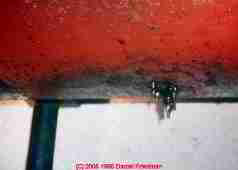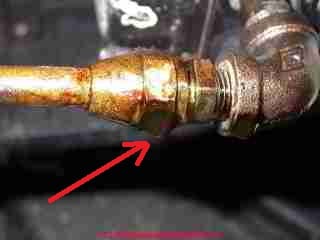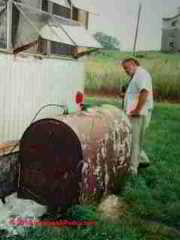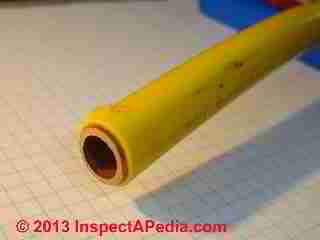 Locating Heating Oil Storage Tank Leaks
Locating Heating Oil Storage Tank Leaks
Where do leaks occur in heating oil storage tanks & what causes them?
- POST a QUESTION or COMMENT about the cause, detection, and repair of leaky oil storage tanks at residential & light commercial properties
Causes & locations of oil storage tank leaks:
This article describes the causes of leaks in buried oil tanks and above ground oil storage tanks and the common points at which oil storage tank leaks are most likely to be found.
Water may leak into oil storage tanks, or may enter tanks by other means; oil such as heating oil or fuel oil may leak out of oil storage tanks, risking a costly environmental problem.
InspectAPedia tolerates no conflicts of interest. We have no relationship with advertisers, products, or services discussed at this website.
- Daniel Friedman, Publisher/Editor/Author - See WHO ARE WE?
What are the Causes of Oil Tank Leaks & Spills?
 At least some of these causes of oil leaks or spills can be avoided by simple inspection and maintenance. The modest
oil spill shown in this photo could have been avoided by properly sealing the brass oil line fittings at the bottom of the oil storage tank.
At least some of these causes of oil leaks or spills can be avoided by simple inspection and maintenance. The modest
oil spill shown in this photo could have been avoided by properly sealing the brass oil line fittings at the bottom of the oil storage tank.
[Click to enlarge any image]
On an outdoor or buried oil tank a leak like this could go un-detected for many years and could form a more serious oil spill.
This is a chapter of our "Heating Oil Underground & Above ground Oil Storage Tank Leaks, Testing, Problems & Solutions, Home Buyer's / Home Owner's Guide" which offers extensive free un-biased oil storage tank inspection and testing advice for property buyers and owners.
In-Tank corrosion: Underground fuel or heating oil storage tanks usually fail from rust perforation due to several effects of water inside the tank including, in the case of heating oil, combination of water with sulphur in the fuel, bacterial action, and other factors.
External rust, unless very heavy, isn't highly correlated with internal rust. Leaks can occur due to tank damage or at piping connections.
Oil Tanks in Corrosive Soils: Oil storage tank leaks are more likely if a steel tank has been buried in corrosive soil or if the tank was damaged during installation, such as gouging it or bouncing it off of a rock as it was placed into a hole for burying.
Oil Tank Piping Leaks: Oil tank leaks may occur at buried piping connections as well.
Delivery Oil Spills: occur around the tank fill pipe and range from trivial to more extensive requiring soil removal and cleaning. These leaks are usually obvious at the ground surface around the oil tank or tank filler.
Inadequate fill or vent pipe diameter is blamed by some for leaks at buried or above ground oil tanks, asserting that because oil tanks are filled under pressure from the oil delivery pumper-truck, a corroded, damaged, or poorly-plumbed oil storage tank, or one with a too-small vent opening, may not withstand the pressure of the filling process.
Indoor oil spills during tank fill or later from a leaky oil tank range from trivial local cleanup and deodorizing efforts to very serious contamination problems if an oil tank bursts during oil delivery (which I suspect is rare) and on occasions when an indoor oil tank has been removed but someone (some fool) has left the oil filler pipe installed on the building, and when subsequently an oil delivery is mistakenly made through the filler pipe onto the empty basement or crawl space floor. This may sound crazy but it actually happens.
Home buyers should be sure to review
OIL TANK LEAK TEST METHODS - Leaky Heating Oil Tanks - How Oil Tanks are Tested for Evidence Leaks, of Current or Previous Oil Spills
and OIL TANK LEGAL ISSUES - home Buyers and Home Owners Guide to Leaky Heating Oil Tanks - What to Do About & When to Report Oil Tank Leaks.
Home owners who have old oil tanks above ground or any age oil tank below ground should also be sure to review
OIL TANK ABANDONING PROCEDURE - Abandoning Commercial vs. Residential Underground Oil Storage Tanks (UST) - Procedures & Regulations A separate website addresses Septic Tanks.
What are the most-common sources of heating & fuel oil leaks in storage systems?
Question/Comment: researching statistical data on percentage of leaks in oil piping systems vs. leaks in oil storage tanks
 I am searching for reliable information on statistical data about the percentage of leaks in suction piping systems, considering USTs before USEPA Regulations (80’s), in comparison to leaks in USTs.
I am searching for reliable information on statistical data about the percentage of leaks in suction piping systems, considering USTs before USEPA Regulations (80’s), in comparison to leaks in USTs.
I have worked for Shell in Brazil for several years, our petroleum regulatory agency has no data on it, and the state environmental regulatory agency has no data either.
If there is any link or peace of good information that you van lead me to it, I will appreciate the indication.
[Photo at left by InspectApedia.com illustrates leaky flange and brass-to-steel threaaded adapter at an oil burner]]
Roberto Abdalla
Concré-S Gestão Empresarial
Diretor de Meio Ambiente
Brasil
Reply: some reasons for lack of early UST, AST, & fuel or heating oil piping leak data
 Siento que eo não falo portugés Sr. Roberto but discussing in Ingléa, you raise a very interesting oil leak data question for which I have not seen nor been able to find satisfying data; but as I'm not an expert researcher on the topic, we can probably find some credible research - perhaps via Google Scholar or from other industry experts.
Siento que eo não falo portugés Sr. Roberto but discussing in Ingléa, you raise a very interesting oil leak data question for which I have not seen nor been able to find satisfying data; but as I'm not an expert researcher on the topic, we can probably find some credible research - perhaps via Google Scholar or from other industry experts.
Previously I have reported on old data on oil tank leaks in the northeastern U.S. - that original data at the source (Fuel Oil & Oil Heat Magazine) subsequently seemed to disappear from public view though the publication itself continues.
See OIL TANK LIFE, ABOVEGROUND
We might approach EPA and other sources to see if there is funding to finance a well-designed study. However as later discussion and comments from both of us will make clear, there are some uncertainties about just manyreports of oil storage system leak rates & occurences, even though leak reporting is mandatory in some countries (such as the U.S. EPA regulations to which you refer.)
As a property inspector alert for signs of possible UST or UST piping leaks over some years I developed some opinions about clues one might see that would raise a red flag and call further testing.
Because of the occasional very large oil spill cleanup costs involved, I and surely other field investigators encounter questionable situations (to put it politely) where a property owner or even an oil delivery company knew that leaks had occurred but didn't want to report that condition.
At a few inspections the property owner basically threw us off of the land rather than permit us to even raise a question about the possibility of underground oil storage tanks, and in other cases clients reported that a seller would not permit leak or contamination testing.
Such oil contamination problems linger until the property is sold and the new buyer, being diligent, has some inspetions and tests performed. Some of my advice to property buyers is at OIL TANK, BURIED, ADVICE.
Follow-up & Discussion about the most-common sources of heating & fuel oil leaks in storage systems
 Study Reports Sources of Underground Oil Storage Tank Leaks
Study Reports Sources of Underground Oil Storage Tank Leaks
R.A. -> D.F.
I have done some library search and found a very interesting study from the Missouri Petroleum Storage Tank Insurance Fund [8][23][24][25][29] (figure at left) and some additional data from Maryland [30].
[Click to enlarge any image]
[Underpinning the data shown at left, the PSIF has insured 7093 oil storage tanks thorugh December 2012, has paid 1061 claims and has 421 outstanding. Ed. - Source MIssouri PSIF Facts & Finances Decembe 2012][8]
Those two studies make sense to me and are well aligned with my initial perception and personal experience.
Steel piping failures are harder to detect especially when we consider hand stick measuring systems and no automatic reconciliation procedures as it was by the eight´s.
In Brazil, we started moving from steel piping to HDPE in 1994 and by 1996 100% off all new installations were made off HDPE pipes, HDPE sumps, etc.
In general, we do not use pressure lines and we can consider that all of it is based on suctions systems (Tank/Pump System) with check valves.
Reply: DF -> R.A. - About the the most common UST, AST & Oil piping leak points,
Documented in more detail at OIL TANK LEAK POINTS it is my OPINION that
 For oil piping leaks, soil chemistry, movement, mechanical damage are most common problem causes if we exclude poorly made pipe joints;
For oil piping leaks, soil chemistry, movement, mechanical damage are most common problem causes if we exclude poorly made pipe joints;
Poorly made pipe joint leaks probably occur more often than piping damage leaks along the length of the pipe itself, though flexible copper oil piping widely used at residential UST and AST installations can be leaky from corrosion and abrasion. That's surely why new residential oil piping is usually installed using HDPE-covered flexible 3/8" or larger L-copper.
A very common leak at above ground tanks that I see is around fill, vent, and fuel level gauges - particularly where deliveries are of large tanks (the driver walks away to smoke a cigarette and fails to stand by the fill pipe listening for the tank alarm to indicate that the tank is full) and in very cold weather (the driver retires to sit in the warm cab of the tank truck);
I also see leaks due to overfilling when the tank alarm (whistle) is not installed or not working; I've published details about oil piping leaks
at OIL TANK PIPING & PIPING DEFECTS.
But I've not found statistical data on these occurrences nor their rates before and after various regulations are enacted.
Short of a funded study, we could of course informally poll oil delivery companies but I'm not optimistic that the data will be so accurate; oil leaks, spills, and cleanups are controversial and bad publicity for the oil industry, making for under-reporting at every opportunity; Those reservations make reports such as the one you fouind, from the insurance industry, all the more interesting and important.
It is always useful to understand differences of practice among countries;
About not using pressure lines for oil piping, in North America (U.S. & Canada) larger heating systems and commercial processes using oil heated boilers & equipment often use NO. 6 heating oil - very thick dirty fuel that can only be moved successfully to the burner by a combination of heating and a pump system.
There is still a vacuum type pump at the oil burner, but pressure-piping may be used to circulate and heat oil; And on a two-pipe oil line installation, a return pipe from the fuel unit (oil burner pump) takes excess oil back to the oil tank - that line is under pressure, not vacuum, when the burner is operating.
How do we prove that an oil tank is not leaking
The Missouri PSIF lists the following seven methods that the insurance fund will accept as evidence that a fuel/heating oil storage system is not leaking - listed just below, but because these tanks address different environments and kinds of potential leaks it's not clear to us that any single test is a complete guarantee about oil leaks:
- Automatic Tank Gauging (ATG)
- Stastical Inventory Reconciliation (SIR)
- Interstitial Monitoring (IM)
- Daily Inventory Control & Annual Tank tightness Testing (DIC)
- Vapor Monitoring (VM)
- Groundwater Monitoring (GW)
- Manual Tank Gauging (MTG)
- Source MIssouri PSIF Insuring Tanks [8]
Reply: R.A. -> DF: further research on & field experience reports of sources of fuel oil & heating oil leak points
I could not agree more with your opinion about why [heating oil] pipes leak. Back in 1989, when I started working with gas stations, USTs & heating/fuel oil pump installations, every piece of pipe was made of steel and all joints were threaded. The biggest steel length used at that time was 6 meters, and a typical connection line between UST and pump was about 10 meters[ - requiring multiple connections, where more connections means more leak risk].
As an average, we can consider that those connection lines had about 10 to 12 threaded connections (Joints, curves, elbows), or potential leak points; and as you very correctly said, mechanical stress and poorly made services caused most of the leaks.
At that time, those[oil piping, tank to appliance] connection lines had no check valves; instead we used foot valves, turning [oil] leak detection an enormous challenge considering that leaks were of a very small in instantaneous volume, constant in duration and random in location.
Statistics about leaking points are very hard to find and the reason is quite simple
- First, nobody likes to talk about it. When a leak was found at that time all effort was made to fix the situation as fast as possible and a little or no attention was given to the reasons why the leak occurred.
- Second, we had no tightness test companies like in the US working in Brazil and the UST installation companies handled all UST testing services with pressure tests or hydrostatic tests. This system was not accurate and those companies generated no data.
- Third, our first legislation about tightness test started back in 1992 and the first major testing program started in 1994. Once again, all data generated at that time was lost. We were moving fast to HDPE, so every leaking steel pipeline found had to be changed by a new HDPE pipeline and a check valve have to inserted on the system in substitution to the foot valve. In fact, some companies decided that if there was any line leaking at the gas station, all pipelines have to replaced, using HDPE.
Taknology was one of the first companies to start a successful local operation and they really did an outstanding job. Several others came and then the market exploded for the UST tightness test segment until late 1990´s.
By 2000 no more steel pipes were allowed in gas stations in Brazil and all old ones were under conversion to HDPE with suction systems, as it is today. I took part in this study - it was very informative. I will be continuing to dig around for data on oil leaks.
...
Continue reading at OIL TANK LEAK TEST METHODS or select a topic from the closely-related articles below, or see the complete ARTICLE INDEX.
If your oil tank is leaking see OIL TANK LEAK & ODOR ADVICE.
Suggested citation for this web page
OIL TANK LEAK POINTS at InspectApedia.com - online encyclopedia of building & environmental inspection, testing, diagnosis, repair, & problem prevention advice.
Or see this
INDEX to RELATED ARTICLES: ARTICLE INDEX to HEATING OIL, OIL BURNERS, OIL FIRED HEATERS, OIL TANKS
Or use the SEARCH BOX found below to Ask a Question or Search InspectApedia
Ask a Question or Search InspectApedia
Try the search box just below, or if you prefer, post a question or comment in the Comments box below and we will respond promptly.
Search the InspectApedia website
Note: appearance of your Comment below may be delayed: if your comment contains an image, photograph, web link, or text that looks to the software as if it might be a web link, your posting will appear after it has been approved by a moderator. Apologies for the delay.
Only one image can be added per comment but you can post as many comments, and therefore images, as you like.
You will not receive a notification when a response to your question has been posted.
Please bookmark this page to make it easy for you to check back for our response.
IF above you see "Comment Form is loading comments..." then COMMENT BOX - countable.ca / bawkbox.com IS NOT WORKING.
In any case you are welcome to send an email directly to us at InspectApedia.com at editor@inspectApedia.com
We'll reply to you directly. Please help us help you by noting, in your email, the URL of the InspectApedia page where you wanted to comment.
Citations & References
In addition to any citations in the article above, a full list is available on request.
- [1] Fuel Storage] Tank Corrosion Study, U.S. EPA report on gasoline and oil tank corrosion, James H. Pim, P.E., John M. Searing, Suffolk County DOHS, 15 Horseblock Place, Farmingville Long Island, NY 11728, November 1988, for the Office of Underground Storage Tanks, U.S. EPA. ATTN: David O'Brien. The report presents a study of 500 underground storage tanks spanning 24 February 1987 and September 1 1988 and summarizes earlier reports on this same study. Tank sizes ranged from 175 gallons to 50,000 gallons, and oil tank ages ranged from two years to 70 years old. All 500 oil storage tanks were constructed of welded steel, and 12 other tanks that were other than plain steel were also examined. Summary [with minor edits for clarity by DJF]
Five hundred plain steel [underground fuel storage] tanks plus twelve corrosion protected [under ground oil] storage tanks were removed from the ground over an eighteen month period in Suffolk County, Long Island, New York. The oil tanks were examined carefully before disposal to gather statistics on the nature and extent of steel oil storage tank corrosion that had attacked them. Information was gathered on the number, type, location, and size of oil storage tank perforations [oil storage tank leak points] the general interior and exterior corrosion condition of the oil storage tank, soil, backfill, and groundwater conditions; the presence of leaked product [heating oil], and oil storage tank statistics such as tank volume, steel plate thickness, location, product [type of heating oil stored], tank age, etc. The statistics were compiled and compared, observations made, and conclusions developed. The major conclusions [were] summarized as follows:- Size is more important than age in predicting oil storage tank failures
- In general, small tanks are much more likely to perforate than large tanks due to thinner walls found in smaller oil storage tanks
- Compared to external corrosion, internal corrosion is insignificant [in the underground oil storage tanks examined - warning from DF: the opposite is probably the case regarding above ground storage tanks].
- Fuel oil tanks are just as susceptible to leak perforation as gasoline tanks of the same size
- Existing fuel storage tanks are in worse shape than is demonstrated by storage tank testing
- Storage tanks to not always leak immediately on perforation
- [2] Thanks to Arlene Puentes for for technical edits on oil tank leak advice- 12/2005. Arlene Puentes is a licensed home inspector, educator, and building failures researcher in Kingston, NY.
- [3] "A Case Study of a Large Scale Precision [oil or fuel] Tank Testing Program", Diane H. Heck, Tetra Tech Richardson, Newark, Delaware, web search 4/27/12, original source: info.ngwa.org/GWOL/pdf/870143411.PDF, copy on file as /heating/OIl Tanks UST/Tank_Test_Heck_870143411.pdf
- [4] Fuel Oil and Oil Heat Magazine, August 1985 p.18. Fuel Oil & Oil Heating Magazine, 3621 Hill Rd., Parsippany, NJ 07054, 973-331-9545
- [5] Standards of the National Board of Fire Underwriters, as referenced by "Domestic and Commercial Oil Burners,", Charles H. Burkhardt, 1961, 3rd Ed., McGraw Hill Book Company, p. 172
- [6] NFPA - the National Fire Protection Association can be found online at www.nfpa.org
- [7] "The Interim Prohibition Guidance for Design and Installation of Underground Oil Storage Tanks", U.S. EPA, EPA/530-SW-85203, Office of Underground Storage Tanks, Washington D.C.
- [8] Missouri Petroleum Storage Tank Insurance Fund (PSIF), PO Box 836, Jefferson City MO 65102, Tel: 800-7565-2765 website: http://www.pstif.org/ retrieved 1/24/2013 - Quoting from the PSIF website:
The Petroleum Storage Tank Insurance Fund was first established by the Missouri General Assembly in 1989, in response to federal legislation requiring owners and operators of underground storage tanks (USTs) to have financial resources available to pay for cleanup of spills and/or leaks from their tanks. Originally called the "Underground Storage Tank Insurance Fund," it began insuring owners and operators of such tanks in May 1992. ... In 1995, the Missouri Legislature expanded the responsibilities of the Fund to include cleanup of sites where USTs had been closed. The same bill authorized PSTIF to pay ongoing costs of cleanup at insured sites where a spill/leak had occurred before the owner was insured by PSTIF. In 1996, the program was again expanded to offer insurance coverage to certain aboveground storage tank owners/operators, and to pay for cleanup of properties where ASTs had previously operated.
Watch out: State law specifies that the Fund will expire on December 31, 2020. - [9] US EPA "How do you Properly Close a UST?" is summarized at epa.gov/OUST/fsprevnt.htm These details for temporary and permanent closing of underground oil storage tanks are provided by the US EPA as well.
- [10] "How do you choose the right tank testing method?", Cynthia Johnson, Fuel Oil & Oil Heat Magazine, November 1995
- [11] National Association of Oil Heat Service Managers, PO Box 380, Elmwood Park, NJ 07407
- [12] "Homeowners Guide to Fuel Storage," Agway Energy Products, Verbank, NY, November 1990
- [13] "Causes of Underground Corrosion", Harco Corporation, Paper HC-36, Median OH
- [14] "Toxicological profile for fuel oils", U.S. Department of Health and Human Services, Public Health Service, Agency for Toxic Substances and Disease Registry (ATSDR) Atlanta, GA 1995. - http://www.atsdr.cdc.gov/toxprofiles/tp75.html
- [15] Public Health Statement for Fuel Oils, ATSDR, (the full document original source can be found at http://www.atsdr.cdc.gov/toxprofiles/phs75.html). An excerpt from this document is just below. ATSDR,
Division of Toxicology, 1600 Clifton Road NE, Mailstop F-32, Atlanta, GA 30333 888-422-8737. - [16] Heating Oil Exposure Health Effects - The ATSDR section on health effects of exposure to heating oil see-ATSDR
- [17] Heating Oil Chemical Properties - ATSDR
- [18] Potential for Human Exposure to Heating Oil - ATSDR - 1.5 How can fuel oils affect my health?
- [19] "Home Heating Oil Spills, Fact Sheet", Connecticut Department of Public Health
- [20] "Home Heating Oil Spills", Wisconsin Department of Health, at http://dhs.wisconsin.gov/eh/Air/fs/Oilspill.htm
- [21] MSDS for No. 2 Home Heating Oil - provided by Hess Oil Company
- [23] Missouri PST Insurance Fund, Report on Private Insurance, 2011, (PSIF), PO Box 836, Jefferson City MO 65102, Tel: 800-7565-2765 website: http://www.pstif.org/ retrieved 1/24/2013, original source: http://www.pstif.org/apps/private_ins_rpt_11.pdf [copy on file as MissouriPSIFprivate_ins_rpt_11.pdf ]
- [24] Missouri PSTF, 20 Years and Going Strong, (PSIF), PO Box 836, Jefferson City MO 65102, Tel: 800-7565-2765 website: http://www.pstif.org/ retrieved 1/24/2013, original source: http://www.pstif.org/apps/final_20th_anniv_rpt.pdf [copy on file as MissourPSIF_20th_anniv_rpt.pdf ]
- [25] Lee Bowron, "Missouri PSTF Review of Liabilities and Loss Projections as of June 2011", Actuarial Study,
- [26] Mackay, D.M., N. de Sieyes, M. Einarson, K. Feris, A. Pappas, I. Wood, L. Jacobson, L. Justice, M. Noske, K. Scow, J. Wilson. 2006. “Impact of Ethanol on the Natural Attenuation of Benzene, Toluene, and o-Xylene in a Normally Sulfate-Reducing Aquifer,” Environmental Science and Technology, Volume 40
- [27] USGAO. 2007. Leaking Underground Storage Tanks: EPA Should Take Steps to Better Ensure the Effective Use of Public Funding for Cleanups. GAO-07-152
- [28] USGAO [U.S. Government Accountability Office]. 2005. Environmental Protection: More Complete Data and Continued Emphasis on Leak Prevention Could Improve EPA’s Underground Storage Tank Program. GAO-06-45
- [29] "Section 7, Ground Water & Underground Storage Tanks", Groundwater Protection Council, The Ground Water Protection Council 13308 N. MacArthur Oklahoma City, OK 73142 Tel: 405-516-4972, Website: http://www.gwpc.org/, retrieved 1/24/2013, original source http://www.gwpc.org/sites/default/files/files/ Underground %20Storage%20Tanks %20-%20Full%20Chapter.pdf
- [30] Diane H. Heck, "A Case Study of a Large Scale Precision Tank Testing Program," Tetra Tech Richardson, Newark, Delaware, copy on file as Oil_Tank_Testing_DianeHeck870143411.PDF
- Our recommended books about building & mechanical systems design, inspection, problem diagnosis, and repair, and about indoor environment and IAQ testing, diagnosis, and cleanup are at the InspectAPedia Bookstore. Also see our Book Reviews - InspectAPedia.
- In addition to citations & references found in this article, see the research citations given at the end of the related articles found at our suggested
CONTINUE READING or RECOMMENDED ARTICLES.
- Carson, Dunlop & Associates Ltd., 120 Carlton Street Suite 407, Toronto ON M5A 4K2. Tel: (416) 964-9415 1-800-268-7070 Email: info@carsondunlop.com. Alan Carson is a past president of ASHI, the American Society of Home Inspectors.
Thanks to Alan Carson and Bob Dunlop, for permission for InspectAPedia to use text excerpts from The HOME REFERENCE BOOK - the Encyclopedia of Homes and to use illustrations from The ILLUSTRATED HOME .
Carson Dunlop Associates provides extensive home inspection education and report writing material. In gratitude we provide links to tsome Carson Dunlop Associates products and services.

